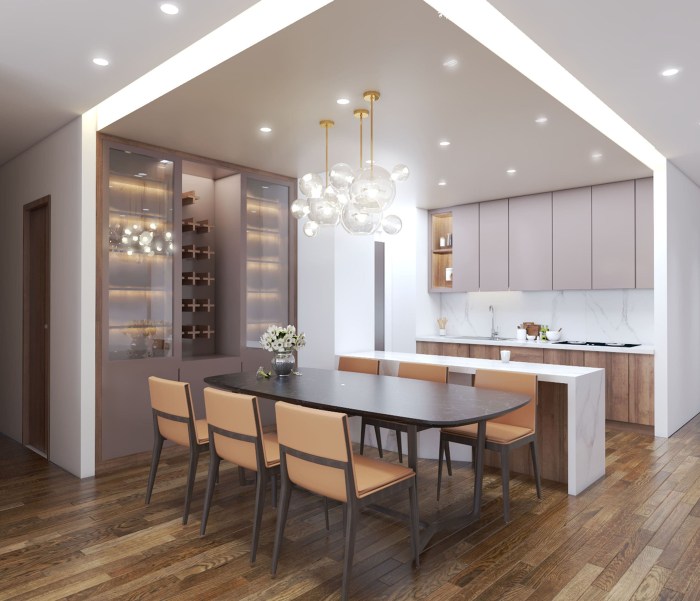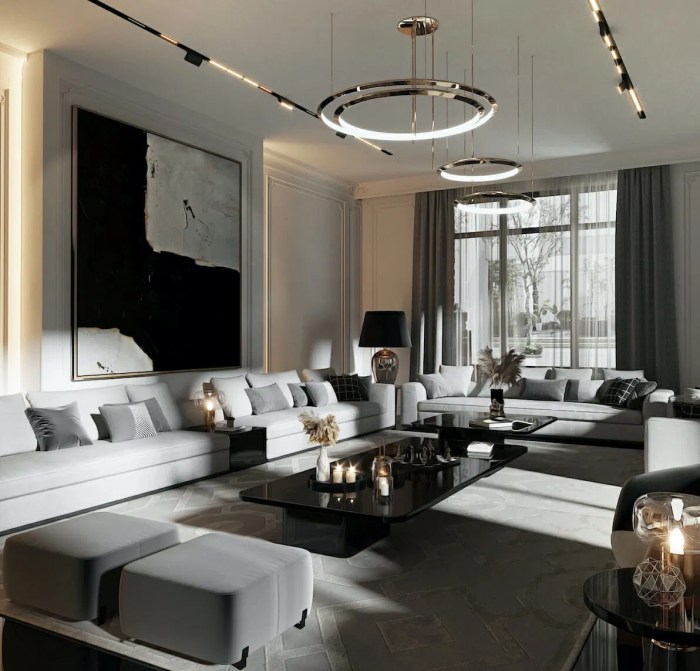Illuminate Your Space: A Guide to Interior Lighting Design
Embark on a journey through the world of interior lighting design, where every corner is brought to life with the flick of a switch. From setting the perfect mood to enhancing functionality, lighting plays a crucial role in transforming any space.
Let's dive into the intricacies of interior lighting design and discover how light can truly make a difference.
Overview of Interior Lighting Design
Interior lighting design involves planning and implementing lighting solutions to enhance the aesthetics, functionality, and mood of indoor spaces. It is a crucial aspect of interior design that requires careful consideration to create the desired ambiance and meet the practical lighting needs of a space.Lighting plays a vital role in interior design as it has the power to transform the look and feel of a room.
Proper lighting can highlight architectural features, create focal points, and set the overall ambiance. It can also affect the perception of space, making rooms feel larger or cozier depending on the lighting design.Different types of lighting fixtures are used in interior design to achieve various lighting effects.
These include ambient lighting, which provides overall illumination; task lighting, which is focused on specific areas for activities like reading or cooking; and accent lighting, which highlights particular objects or architectural elements.
Types of Lighting in Interior Design
- Ambient Lighting: Also known as general lighting, ambient lighting provides overall illumination to create a comfortable and inviting atmosphere in a room. It can be achieved through ceiling-mounted fixtures, chandeliers, or wall sconces.
- Task Lighting: Task lighting is used to illuminate specific areas where activities like reading, cooking, or working take place. Desk lamps, under-cabinet lighting, and pendant lights are common examples of task lighting fixtures.
- Accent Lighting: Accent lighting is used to highlight focal points, artwork, or architectural features in a space. Track lighting, wall-mounted fixtures, and recessed lights are often used for accent lighting to create visual interest and drama.
Principles of Interior Lighting Design

Interior lighting design is crucial in creating the right ambiance and functionality within a space. Key principles such as layering, task lighting, ambient lighting, and accent lighting play a significant role in achieving a well-balanced and visually appealing environment. Let's delve into these principles and explore how they can be effectively applied in different interior spaces.
Importance of Natural Light
Natural light is a fundamental element in interior design as it not only enhances the overall aesthetic appeal but also has a positive impact on our well-being. Incorporating natural light into a space can help reduce energy consumption, improve mood, and create a sense of openness and connection to the outdoors.
Balance of Different Lighting Types
To achieve optimal results in interior lighting design, it is essential to strike a balance between different types of lighting. Layering various sources of light, including ambient, task, and accent lighting, allows for flexibility in creating different moods and highlighting specific areas within a space.
By carefully balancing these elements, you can ensure that every corner of the room is adequately illuminated while maintaining a cohesive and visually appealing look.
Examples of Effective Lighting Design
Effective lighting design can greatly enhance the aesthetics and functionality of various interior spaces. For example, in a living room, a combination of ambient lighting with strategically placed accent lights can create a warm and inviting atmosphere for entertaining guests.
In a kitchen, task lighting under cabinets and over work areas can improve visibility and productivity. Similarly, in a bedroom, a mix of ambient lighting and bedside lamps can create a cozy and relaxing environment for rest and relaxation.
Types of Lighting Fixtures
When it comes to interior lighting design, choosing the right type of lighting fixture is essential to achieving the desired ambiance and functionality in a space. There are various types of lighting fixtures commonly used in interior design, each with its own unique characteristics and benefits.
Chandeliers
Chandeliers are elegant and decorative lighting fixtures that are often used as a focal point in a room. They come in a variety of styles, sizes, and materials, making them suitable for various design aesthetics. Chandeliers are typically hung from the ceiling and can provide both ambient and task lighting depending on the design.
Pendants
Pendants are versatile lighting fixtures that can be used in a variety of spaces, from kitchens to bedrooms. They are often suspended from the ceiling by a rod, chain, or cord, and come in different shapes, sizes, and styles. Pendants are great for adding focused task lighting or creating visual interest in a room.
Sconces
Sconces are wall-mounted lighting fixtures that can be used to provide ambient, task, or accent lighting. They are ideal for illuminating hallways, staircases, or as bedside lighting
Recessed Lighting
Recessed lighting, also known as can lights or pot lights, is a popular choice for modern interior spaces. These fixtures are installed into the ceiling or walls, creating a sleek and minimalist look. Recessed lighting is great for providing ambient lighting without taking up visual space and can be used to highlight specific areas or architectural features.
Choosing the Right Fixture
When selecting a lighting fixture for a specific space, consider the size of the room, the desired lighting effect, and the overall design style. For example, a large chandelier may be suitable for a grand dining room, while a series of pendants can work well in a kitchen island.
It's essential to balance aesthetics with functionality to create a cohesive and well-lit space.
Incorporating Lighting Fixtures
To incorporate lighting fixtures into different interior design schemes, consider layering different types of lighting for a balanced and dynamic look. Mix ambient, task, and accent lighting to create depth and visual interest in a room. Experiment with different fixture styles, sizes, and placements to find the perfect lighting solution for each space.
Lighting Design Techniques

Creating a well-thought-out lighting plan is essential when designing the lighting for a room or space. This involves considering the function of the space, the desired ambiance, and the activities that will take place in the area.
Lighting Layers
Implementing lighting layers involves using different types of lighting fixtures to create depth and dimension in a space. This typically includes ambient lighting (general illumination), task lighting (focused light for specific activities), and accent lighting (highlighting specific features or objects).
- Ambient lighting provides overall illumination for a room and is usually achieved through ceiling lights or wall sconces.
- Task lighting is important for activities like reading or cooking and can be provided by desk lamps, under cabinet lights, or pendant lights.
- Accent lighting can be used to draw attention to artwork, architectural features, or decorative elements using track lighting, recessed lights, or wall-mounted fixtures.
Controlling Light
Controlling light intensity, color temperature, and direction can greatly impact the mood and functionality of a space. Dimmer switches allow for adjusting light levels, while choosing bulbs with different color temperatures can create warm or cool lighting effects. Directional fixtures like adjustable spotlights or wall washers can be used to focus light where needed.
Innovative Techniques
Professionals often use innovative lighting design techniques to enhance a space. This can include using LED tape lights to create hidden lighting effects, incorporating smart lighting systems for remote control and automation, or integrating lighting with architectural elements for a seamless design.
Final Review
As we reach the end of our exploration into interior lighting design, it's clear that the right lighting can elevate any room from ordinary to extraordinary. With a mix of different lighting fixtures, techniques, and principles, you have the power to create a space that not only looks stunning but also feels inviting and functional.
So go ahead, light up your world with the magic of interior lighting design.
FAQ Guide
What is interior lighting design?
Interior lighting design involves planning and implementing lighting solutions to enhance the aesthetics and functionality of a space.
How does lighting impact the mood of a space?
Lighting can create different atmospheres in a room, affecting the mood and ambiance based on factors like intensity and color temperature.
What are some common types of lighting fixtures used in interior design?
Common lighting fixtures include chandeliers, pendants, sconces, and recessed lighting, each offering unique aesthetics and functionality.
Why is natural light important in interior design?
Natural light not only brightens up a space but also creates a sense of openness and connection to the outdoors, enhancing the overall design.
How can one choose the right lighting fixture for a specific space?
Consider the size of the space, the design style, and the desired lighting effects when selecting a fixture to ensure it complements the overall aesthetics.




